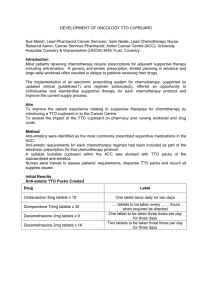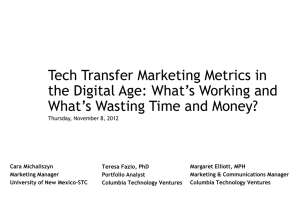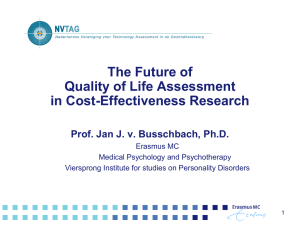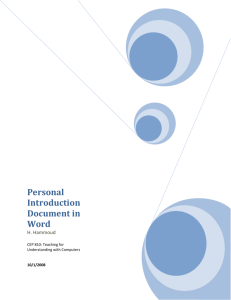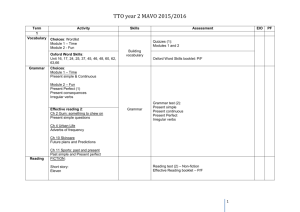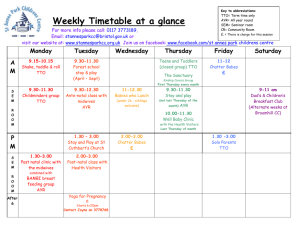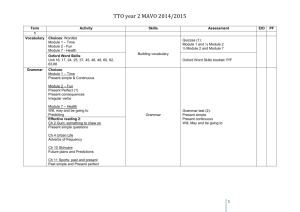Full Text (Final Version , 1mb)
advertisement
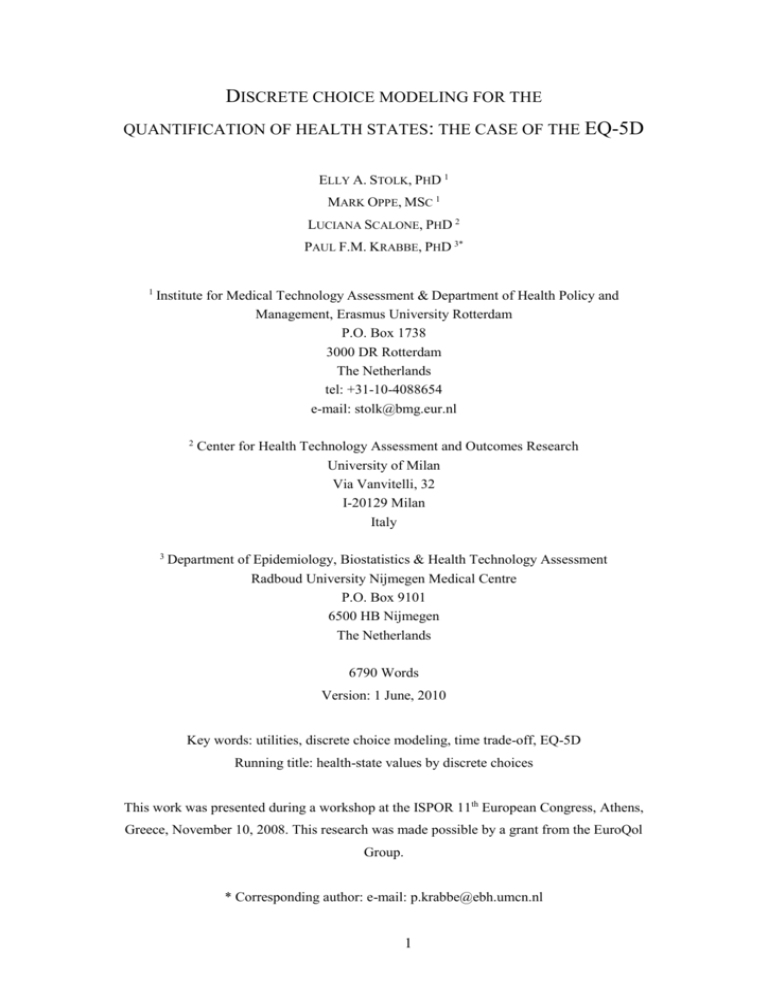
DISCRETE CHOICE MODELING FOR THE QUANTIFICATION OF HEALTH STATES: THE CASE OF THE EQ-5D ELLY A. STOLK, PHD 1 MARK OPPE, MSC 1 LUCIANA SCALONE, PHD 2 PAUL F.M. KRABBE, PHD 3* 1 Institute for Medical Technology Assessment & Department of Health Policy and Management, Erasmus University Rotterdam P.O. Box 1738 3000 DR Rotterdam The Netherlands tel: +31-10-4088654 e-mail: stolk@bmg.eur.nl 2 3 Center for Health Technology Assessment and Outcomes Research University of Milan Via Vanvitelli, 32 I-20129 Milan Italy Department of Epidemiology, Biostatistics & Health Technology Assessment Radboud University Nijmegen Medical Centre P.O. Box 9101 6500 HB Nijmegen The Netherlands 6790 Words Version: 1 June, 2010 Key words: utilities, discrete choice modeling, time trade-off, EQ-5D Running title: health-state values by discrete choices This work was presented during a workshop at the ISPOR 11th European Congress, Athens, Greece, November 10, 2008. This research was made possible by a grant from the EuroQol Group. * Corresponding author: e-mail: p.krabbe@ebh.umcn.nl 1 ABSTRACT Objectives: Probabilistic models have been developed to establish the relative merit of subjective phenomena by means of specific judgmental tasks involving discrete choices. The attractiveness of these discrete choice (DC) models is that they are embedded in a strong theoretical measurement framework and are based on relatively simple judgmental tasks. The aim of our study was to determine whether the values derived from a DC experiment are comparable to those obtained using other valuation techniques, in particular the time trade-off (TTO). Methods: 209 students completed several tasks in which we collected DC, rank, VAS, and TTO responses. DC data were also collected in a general population sample (N=444). The DC experiment was designed using a Bayesian approach and involved 60 choices between two health states and a comparison of all health states to being dead. The DC data were analyzed using a conditional logit and a rank-ordered logit model, relying respectively on TTO values and the value for being dead to anchor the DC-derived values to the 0-1 QALY scale. Results: Although modeled DC data broadly replicated the pattern found in TTO responses, the DC consistently produced higher values. The two methods for anchoring DC-derived values on the QALY scale produced similar results. Conclusions: On the basis of the high level of comparability between DC-derived values and TTO values, future valuation studies based on a combination of these two techniques may be considered. The results further suggest that DC can potentially be used as a substitute for TTO. 2 INTRODUCTION Composite measures of health outcomes such as ‘quality-adjusted life years’ (QALYs) require weights or values attached to different health states that reflect the levels of health associated with these states. The standard gamble (SG) and time trade-off (TTO), which have emerged from health economics research, are frequently used to assign values to health states [1]. Psychology has contributed another technique, the visual analogue scale (VAS) [2]. Unfortunately, there are theoretical and empirical drawbacks to all of these techniques [3]. Responses to the SG and TTO are likely to be influenced by factors extraneous to judgments about health levels, such as risk aversion or time preference. Moreover, empirical violations of the normative axioms supporting the use of these techniques have been noted. Regarding VAS, critics question its interval properties and point to its lack of a relation to economic theory. In the literature on health-state valuation, arguments are raised for and against different techniques, but this debate has not led to consensus [4]. Therefore, but also in light of the diverging empirical results, continued work on improving the methods is warranted. Probabilistic discrete choice (DC) modeling offers an alternative approach for exploring people’s values, although this approach is also not without problems and criticism [5-7]. Such DC models can be used to analyze data obtained through approaches involving choices, ranks, or matches between alternatives, as defined by attributes and levels [8]. The DC models were initially developed for the analysis of real world data, but researchers became quickly aware of their potential for analysis of stated preference data allowing for exploration of a broader range of preference-driven behaviors than possible on basis of real world data [9]. This strategy was first developed in transport economics and marketing. There, instead of modeling people’s actual choices (revealed preferences), Louviere and others modeled the choices made by subjects in carefully constructed experimental studies based on stated preferences: discrete choice experiments (DCE) [9]. The term DCE refers to an experiment that is constructed to collect stated preference data that is consistent with the requirements for 3 DC modeling. Recognizing that the DCE framework offers a conceptual basis for the evaluation of the benefits of health programs, the technique is now being used to extend economic evaluations in health care with information about the value of non-health outcomes such as waiting time, location of treatment, and type of care [10-12]. More recently, DCEs and accompanying DC models have also been considered for health state valuation [13-17]. DC modeling has good prospects for health-state valuation. The statistical literature classifies it among the probabilistic choice models that are grounded in modern measurement theory and consistent with economic theory (i.e., the random utility model). All DC models have in common that they can establish the relative merit of one phenomenon with respect to others. If the phenomena are characterized by specific attributes with certain levels, extended probabilistic choice models would permit estimating the relative importance of the attributes and their associated levels, and even estimating overall values for different combinations of attribute levels. A promising feature of DC models is that the derived values only relate to the attractiveness of a health state; they are not expressed in trade-offs between improved health and something else, as in TTO and SG. Bias due to these extraneous factors may therefore be prevented. Moreover, DC models have a practical advantage: when conducting DCEs, health states may be evaluated in a self-completion format. The scope for valuation research is thereby widened as compared to existing TTO protocols for deriving values for health-state measurement instruments such as EQ-5D. But DC models are not without problems when used for health-state valuation. The analytical procedure on which analysis of DCE data is based assumes that the difference in values between choice options (e.g., two health states) can be inferred from the proportion of respondents that chose one option over the other. This implies that the relative position of all health states on the latent scale would lie between the ‘best’ and the ‘worst’ health states. For the estimation of QALYs, however, those values need to be scaled on the full-health – dead scale. If DC modeling is used to value health, a way must be found to link the derived values under this model to the scale required to calculate QALYs. Yet there is no consensus on what 4 is the best way to handle the arbitrarily scaled DC values obtained, so it remains uncertain just how valid and informative DC-based values are. A strategy for rescaling DC values may be to rescale by anchoring them on values obtained for the best and worst health state using other valuation techniques, such as TTO or SG. However, the rationale for this approach is unclear, when part of the motivation to explore the DC model as a potential candidate to produce health-state values comes from the limitations of existing valuation methods. Alternatively, the DCE may be designed in such a way that the derived health-state values can be related to the value of the state ‘dead’. A simple manner to achieve this seems to be by DCE designs in which respondents are presented one bad health state at a time and asked if they consider it better or worse than being dead. The value difference between these bad health states and being dead would then be estimated from the observed probabilities between the bad health states and being dead. However, Flynn et al. [18] have asserted that the precision of the final estimates for the health states, in particular the region around “dead”, may be largely based on the presence of respondents who consider none of the presented health states to be worse than dead. A problem is that the DC model will not accurately capture the error distribution and therefore produces biased estimates. Furthermore, under random utility theory responses of those who consider all life worth living are perceived to reflect an infinite value difference between health states and dead. This is not necessarily an accurate representation of their preferences, and causes an estimation problem. The values derived from the DC model will then depend on the proportion of respondents who exhibit this preference. These problems in estimating DC models are less likely to arise in studies comparing health states to each other rather than to being dead. By mixing these two designs, the ability to relate the health-state values to being dead may be maintained, while limiting (not omitting) the effect of the aforementioned biases. The procedure has been demonstrated by McCabe et al. [16] and Salomon [5]. These authors mixed the state ‘dead’ in the choice set as a health state, so that a parameter for the state ‘dead’ is estimated as part of the model. 5 Since none of the various methods to anchor DC derived values on the full-health – dead scale required for QALY computation is without problems, it is hard to say which strategy should be used. Experimentation with the various anchoring strategies is therefore required and convergence with alternative methods for health state valuation needs to be explored, to give advice on this manner and to see if any of the proposed strategies is capable of producing health state values that may be accepted by the research community. This paper considers the application of DC modeling for deriving health-state values. Research on novel, enhanced, and feasible measurement tools is conducted by the EuroQol Group to support improvement of the Group’s health-status measurement instrument, the EQ5D. This work is motivated by the perceived limitations of the traditional valuation techniques and by the prospects of DC models for health-state valuation. We analyzed congruence across methods (DC, Rank, VAS, and TTO) and across samples with the aim of determining whether DC modeling produces value estimates that are comparable to traditional methods. The main focus of the study was to compare DC values to values elicited with the standard TTO technique. 6 METHODS EQ-5D states The EuroQol EQ-5D is a generic measurement instrument to describe and value health states [19]. The EQ-5D classification describes health states according to five attributes: mobility; self-care; usual activities; pain/discomfort; and anxiety/depression. Each attribute has three levels: ‘no problems’; ‘some problems’; and ‘severe problems’. Health-state descriptions are constructed by taking one level for each attribute, thus defining 243 (35) distinct health states, where ‘11111’ represents the best and ‘33333’ the worst state. An EQ-5D health state may be converted to a single summary index by applying a formula that essentially attaches weights to each of the levels in each dimension. This formula reflects the values of EQ-5D health states as obtained from respondents in a sample of interest. Usually this is a representative sample of the general population, but in the current study both a student sample and a general population sample were used. Not all EQ-5D states were included in the experiment. We constructed a discrete choice experiment (DCE) of 60 pairs of EQ-5D states, following the methodology described below. For the three other judgmental tasks in our study protocol, a set of 17 EQ-5D health states was selected. The set comprised five very mild, four mild, four moderate, three severe states, and state ‘33333’. The 17 states are: 11112, 11113, 11121, 11131, 11133, 11211, 11312, 12111, 13311, 21111, 22222, 23232, 32211, 32223, 32313, 33323, and 33333. The same 17 states were used in the Dutch EQ-5D TTO valuation study [20]. Respondents For practical reasons, this study included a general population sample (target N=400) and a student sample (target N=200). The comparison across valuation methods and of strategies for anchoring values obtained using DC models relative to dead and full health were done on basis of student data. DC responses were also collected from the general population in order 7 to draw tentative conclusions about the possibility to extrapolate results from the student sample to the general population. Students were recruited at Erasmus University in Rotterdam, The Netherlands. Each student was offered € 20 for participating. The general population sample consisted of members of an Internet panel. This panel included approximately 104,000 people. Stratified sampling was used to select a research sample from the panel that was representative for the Dutch general population in terms of age, gender, and education. The stratified sampling procedure was performed in three rounds, so the final round allowed for over- or undersampling of specific groups if the desired distribution over the strata had not been attained yet. The incentive offered to the panel members consisted of a € 2.50 donation to a charity chosen by the respondent and a chance to win gift certificates or other prizes in a lottery. People in the general population sample were only administered the DCE. The students completed (in this order) the DCE, Ranking, VAS, and TTO task in the presence of one of the researchers or a research assistant. To become familiar with the type of health-state descriptions, all respondents were administered the EQ-5D prior to the judgmental tasks. Judgmental tasks DCE - In the DCE, all respondents were presented with a forced choice between two EQ-5D states. After this paired comparison task, students were prompted to answer a second question related to each of the two health states separately. This extra question offered ‘dead’ as a choice, phrased as “would you rather be dead than living in this health state?” In the remainder of the paper, we will refer to the two outcomes as DCE data and DCEdead data respectively. The DCE was programmed as a computer experiment. Respondents logged in to a website where they were presented with a number of choices between two EQ-5D states that were randomly selected from the choice set (table 2). Our general population sample received nine discrete choices; students received 18 discrete choices, and thus compared 36 states to being dead. It was a pragmatic decision to opt for random selection of choices for an individual, 8 rather than using a blocked design, based on the fact that level balance also was no criterion for design construction, and confidence that systematic effects would be filtered out given the large number of questions and the large sample size. Ranking, VAS, and TTO – The Ranking, VAS, and TTO tasks were performed as described in Lamers et al., 2006 [20]. The valuation procedure may be summarized as follows. First, students rank-ordered the 17 EQ-5D states selected for these tasks, supplemented with ‘dead’ and state ‘11111’, by putting the card with the ‘best’ health state on top and the ‘worst’ one at the bottom. Next, students valued the rank-ordered health states on the EuroQol visual analogue scale (EQ-VAS) using a bisection method that specified the order in which various states needed to be valued. The TTO valuation task followed the VAS valuation. TTO was executed using a Computer Assisted Personal Interviewing (CAPI) method that followed standard TTO protocols based on the original UK study protocol [21]. This implies that the health states were presented in random order, that the TTO task was facilitated by a visual aid, and that the respondents were led by a process of outward titration to select a length of time t in state ‘11111’ (perfect health) that they regarded as equivalent to ten years in the target state (for states better than dead) or to select a length of time (10-t) in the target state followed by t years in state ‘11111’ (for states worse than dead). Experimental design of the DCE The DCE design was constructed using a Bayesian efficient approach, which to our knowledge has not been applied in health economics before. Most DCEs in health economics have applied orthogonal designs. These allow the uncorrelated estimation of main effects, assuming that all interactions are negligible. A limitation of orthogonal designs is that orthogonality is compromised if, for the purpose of data analysis, categorical multi-level variables need to be transformed into a set of dummy variables. Moreover, in optimal orthogonal designs the efficiency of the design is optimized for the situation that choices are made randomly. This is true under the restrictive assumption that the estimates of the 9 parameters in the utility model are equal to zero (β=0). This implies that two choice options within a pair have a 50% probability of being preferred, irrespective of their attribute levels. If β=0 does not hold, the design will not be optimally efficient for producing information in regard to the true parameter effects [22,23]. Both issues with orthogonal designs apply to EQ5D valuation, so we decided to look elsewhere. To construct a Bayesian efficient design, a computer algorithm was used (see Appendix) that was obtained at that time from Rose and Bliemer and described in [24], but which is publicly available now in the software package Ngene. The algorithm entailed an iterative procedure whereby a great many designs, each with the desired number of choice situations, were randomly selected from the full factorial design and compared by their Derror, which was computed on the basis of expected values of the model parameters. In the Bayesian framework these expected values are known as priors. Because the priors were not perfectly known, they were included as distributions from which they were sampled rather than as point estimates in the design algorithm. This way, when priors deviate from their expected values, the impact on the efficiency of the design is minimized. To that end, the Bayesian efficient design algorithm uses nested Monte Carlo simulation. The best design remaining after 2000 iterations, each containing 1000 draws for the priors, was selected for this study. The probability that this design is the optimal one is small since a more efficient design is likely to exist. Even if not optimal, the design will still be efficient, given the large number of iterations in the Monte Carlo simulation. The DC model we intended to estimate included main-effect terms for the five categorical three-level EQ-5D domains (transformed into a set of ten dummies) and the so-called N3 term. This is a non-multiplicative interaction term that is frequently used in EuroQol valuation models. It allows for measuring the ‘extra’ disutility when reporting severe (level 3) problems on at least one EQ domain [19]. In addition, it was considered that the model would need to include an alternative specific constant as recommended in the literature [25] to control for unobserved systematic effects on choices, such as a tendency to always choose the same 10 option. Accordingly, based on degrees of freedom a minimum number of 12 pairs is required to estimate all model parameters. It was decided to increase this number to 60 pairs to allow for extension of the model with interaction terms, if relevant. The priors for the main effects were obtained by taking the weighted average of the parameter estimates from three TTO-based EQ-5D studies [20,21,26]. We used a standard error of 20% surrounding these priors to account for the possibility that parameter estimates modeled on the basis of DCE data might be different from those elicited with TTO. The prior parameter estimates of the interactions were set to 0. The algorithm produced a design of 60 pairwise comparisons of two EQ-5D states. To further improve the design, we identified and altered dominant choices in which logical consistency predicts that one alternative will always be preferred. Nine dominant choices were identified. In five pairs, the worst state was improved to escape from dominance; in the other four, the best state was made worse. The alterations were made randomly, but in accordance with the following rules: 1) the D-efficiency of the design was improved with the alterations; and 2) the new health state was not included yet in the choice set. This strategy resulted in a choice set of 60 pairs including 106 unique health states (94 states were included once, 10 twice, and two were included three times).The final set of 60 states is presented in table 2. The D-error of this design was 1.11. Analysis Observed values derived from Rank, VAS, and TTO responses for 17 states The rank data was analyzed using the ‘law of comparative judgment’ (LCJ) model, as introduced by Thurstone [27, 28]. To model the rankings within the Thurstonian framework, the rankings are transformed (‘exploded’) into paired comparisons. The analytical procedure assumes that the difference in value between two health states can be inferred from the proportion (i.e., probabilities) of respondents who preferred one health state to another. The resulting matrix of probabilities is subsequently transformed into Z-values (i.e., normal 11 distribution). The LCJ values are obtained by taking the mean of all the columns of the Zmatrix, as described by Krabbe [28]. Mean VAS and TTO values were obtained with approaches commonly used in EQ-5D valuation studies [described, for example, in 20-21]. Observed VAS values were obtained on a scale with the endpoints ‘best imaginable health’ (=100) and ‘worst imaginable health’ (=0). To use these values in health-state valuation, they need to be rescaled such that state ‘11111’ has a value of 1 and being dead has a value of 0. Rescaling was performed at the respondent level on the basis of the observed VAS scores for the various health states and the scores that were recorded for ‘dead’ and ‘perfect health’, using the following equation [19]: VAS health state-rescaled VAS health state-raw - DEAD raw 11111raw - DEAD raw The same procedure that was applied in the Dutch valuation study [20] was used for estimating values from TTO responses. For states regarded as better than dead, the TTO value is t/10; for states worse than dead, values are computed as -t/(10-t). These negative health states were subsequently bounded at minus 1 with the commonly used transformation v’ = v/(1-v). Linear regression analysis was used to interpolate values for all EQ-5D states from the values for the 17 states that were observed. Estimated value prediction models and rescaling methods For the TTO task, the predicted values for all 243 EQ-5D states were derived after interpolation from the values for the 17 states that were included in the TTO task. The TTO model included an intercept, interpreted as any deviation from full health, as well as dummy variables for the ten main effects and for the N3 parameter. 12 We modeled and rescaled DCE-derived values in two different ways. The applied DC models were a conditional logit model (estimated only on the DCE data) and a rank-ordered logit model (estimated on DCE and DCEdead data), as explained below. Neither the TTO nor the DC model adjusts for the fact that there are several observations per respondent. First we used the conditional logit model to analyze the DCE data obtained from the 60 pairwise comparisons of EQ-5D states. The model included dummy variables for the ten main effects and the N3 parameter. The values derived from this model are on an undefined scale. To link the DCE-derived health-state values to the QALY scale, we used TTO values for the worst health state (33333) and the best health state (11111) as anchor points for rescaling. For the general population we used TTO values obtained from the Dutch EQ-5D valuation study, i.e. -0.329 [20]. For the student sample, we used the empirical TTO values derived in this study. We will refer to the resulting values as the DC values. Alternatively, we derived health-state values from the DCE data on the QALY scale by anchoring the values on the value for being dead (thus: 0). For this purpose we modeled the information obtained from both the DC and DCdead data. This information was used to deduce how the respondent would have rank ordered the two EQ-5D states and ‘dead’ from most to least preferred. These rank orderings were analyzed using a rank-ordered logit model. Besides the dummy variables for the ten main effects and the N3 parameter, this model also includes a parameter for the state of being dead, which can be used to rescale the values and put them on the full-health – dead (1 – 0) scale, as demonstrated by McCabe et al. [16]. The value for being dead is anchored at zero by dividing all coefficients by the coefficient for ‘dead’. By additionally restricting the value of full health to 1, values are produced in the 0 to 1 range for states better than dead and negative values for states worse than dead. We will refer to the resulting value set as DCdead Across-method and across sample comparison 13 Intraclass correlation coefficients (mixed model, average measures) and mean absolute differences were computed to estimate the degree of correspondence between different methods. The intraclass correlation coefficients was also used to compare the DC derived values of students and the general population. Except for the DC model (Stata 10 SE), all statistical analyses were performed in SPSS (V. 17.0). 14 RESULTS Respondents Data were elicited in a sample of 444 persons in the general population and 209 students. The general population sample was representative in terms of gender, age, and level of education (table 3). All students completed the RANK, VAS and TTO task. They also completed the DC task, but due to a problem with data storage, responses of five students were not saved. DC responses of those who continually chose only one option were removed from the dataset. This applied to six people in the general population sample and none of the students. The DC model was therefore estimated on responses of 204 students and 438 people in the general public. Their responses included no missing values. Preference data elicited in students using Ranks, VAS, and TTO The observed mean values for the 17 health states that were obtained in students using Ranks, VAS, and TTO are presented in table 4 and – supplemented with the DC values – in figure 1. All methods yielded a negative value for state 33333 (rank: -0.06; LCJ: -0.15; VAS: -0.07; TTO: -0.1). Compared to the Dutch TTO-based valuation algorithm, the student sample gave on average slightly higher values for the health states (not presented). The intraclass correlations between the four value sets were high (> 0.96, p<0.001). Yet the absolute values differed across the methods, in particular between VAS and LCJ, between TTO and VAS, and between TTO and LCJ. VAS values tended to be lower than TTO values. However, the mean ranks were similar to the VAS values. This similarity may be caused by the relation between the judgmental tasks of the ranking and VAS: the rank-ordered health states were valued using VAS in a specific order. Application of LCJ to rank data resulted in values that were higher than VAS and TTO values. 15 Comparing DC and TTO Table 5 presents the parameter estimates obtained for DC, DCdead, and TTO. We only report the models that included the N3 parameter, because these performed slightly better than the models without N3. All coefficients were statistically significant, except for mobility level 2 in the TTO model. Despite some differences (e.g. incentives provided, mode of administration, number of judgments) between the two study samples (students, general population) we observed a strong relationship between the DC derived values of the two samples (figure 2). Although more health states seem to be valued negatively by the general population, this is mostly due to the rescaling on the basis of the TTO value for the worst EQ-5D state, ‘33333’: -0.329 for the general population and -0.098 for students. Comparison of figures 2 and 3 suggests that the parameter estimates obtained using DCE in different samples are closer to each other than the DCE-derived and TTO-derived estimates. Figure 3 shows that DC produced higher values than TTO when rescaled on the basis of the TTO values for ‘33333’ and ‘11111’. The intraclass correlation between the TTO and DC values was 0.93 (p < 0.001; confidence interval: 0.12 – 0.98) in the general population and 0.96 (p < 0.001; confidence interval: 0.53 – 0.99) among the students. The mean absolute difference between the student TTO and student DC was 0.060 (SD = 0.039). Absolute values of health states derived by different methods may be different, though in many applications of health-state values the main focus is on marginal differences (e.g., comparisons before and after a medical intervention). Therefore, marginal difference scores for all combinations of the 243 derived EQ-5D states were computed (29,403 combinations) for the TTO and the DC separately (figure 4). This analysis shows again that overall DC values are higher than TTO values and also that marginal differences between TTO and DC values for individual pairs of states can be as large as around 0.20. The mean of marginal differences between DC values and TTO values for individual pairs was 0.086 (SD 0.002). 16 Anchoring DC values on ‘dead’ Students considered a health state to be worse than dead in about 10% of the cases. The DC model parameter estimates derived from the DCdead data are presented in table 5. The values produced by the two different models (DC vs. DCdead) are congruent (figure 5); the intraclass correlation between the two value sets was 0.99 (p < 0.001; confidence interval: 0.92 – 0.99), while the mean absolute difference between the values was 0.019 (SD 0.009). The DCdead values were slightly lower than values derived from the DCE involving pairwise comparison of EQ-5D states, except for mild health states. Therefore, the difference between the DCdead values and the TTO values was slightly smaller than the difference between the DC values and the TTO values. Interaction terms in the DC models The analysis of the DC models expanded with first-order interaction terms showed that ten of the 40 interaction terms were statistically significant. However, three main effects (mobility level 2, pain level 2, depression/anxiety level 2) were no longer statistically significant when compared to the main effect model. The increase in the amount of explained variance (pseudo R2) due to the inclusion of the interaction terms was marginal (main effect: 0.266; main effects + interactions: 0.277). 17 DISCUSSION We have presented a systematic comparison of Ranks and VAS, TTO, and DC (DCE-derived) values for EQ-5D health states in order to investigate whether or not modeling DCE data produces health-state values that are comparable to other conventional valuation techniques, TTO in particular. DC values broadly replicated the pattern found in TTO responses. This observation applies to both samples (general population, students) and, in students, to both strategies that were applied to anchor the DC values on the full-health (= 1) – dead (= 0) scale. Besides similarities, there were also systematic differences. DC values were consistently higher than TTO values, which were in turn higher than VAS values. Values derived from rank data were higher when analyzed using LCJ than when using mean ranks. Instead of the classic Case V model used here, more general Thurstonian models with unrestricted covariance structures may be more appropriate [29]. The results suggest a systematic difference across the methods, with DC values being the highest of all. The fact that differences were found between DC modeling and TTO is in line with the findings of several other studies where DC models have been applied in the analysis of rank or DCE data. Salomon (2003) compared rank-based models and TTO for EQ-5D using data from the UK general population survey. He found that the rank-based models produced slightly higher values [5]. Ratcliffe et al. [14] compared TTO and DC modeling for a diseasespecific outcome measure. DCE-derived values seemed higher than TTO values. A more complex relation was found between rank and TTO data, with better convergence for mild states. McCabe et al. (2006) compared values derived from rank data with standard gamble values for SF-6D and HUI health states; the rank data produced higher values [16]. It thus seems that TTO and DC models are largely measuring the same latent construct (quality of a health state), but the techniques do not produce identical results. The main difficulty we met in applying DC models is that these models generate values on an arbitrary scale, not on the metric of the quality (of life) component of the QALY scale. We 18 have explored the possibility of anchoring the values derived from DCE data on the QALY scale directly by using ‘dead’ as a choice option. This strategy yielded values that were comparable to those derived from the DCE where two EQ-5D states were compared to each other and anchored on the basis of some TTO values. Although this is a promising result with regard to the possibility of using DC models and their associated DCEs as a stand-alone valuation technique, further research is warranted to explore the relationship between the outcomes of the DCEdead approach with a DC model that is anchored on TTO. For example, the difference between the TTO value for state ‘33333’ of students and the general population raises the question whether results about comparability of the two anchoring strategies can be generalized from students to the general population. If combined use of DC modeling and TTO is considered for health-state valuation, the strategy for linking DC and TTO data may need to be further explored. Anchoring on the worst state, 33333, may have contributed to systematic differences between TTO and DC values because of bias resulting from problems of TTO with valuation of states worse than being dead. On the other end of the valuation space, the DC values may be incorrectly anchored with respect to full health. A reliable estimation of the difference between full health and non-optimal states cannot be obtained from the collected choice data, because of the dominance issues similar to the ones pertaining to dead. The problem can be circumvented in a valuation task involving choices involving scenarios that vary quality of life and one other domain of health, such as length of life or risk of dying as suggested by Flynn et al. [18]. However, then health state values would be influenced by risk aversion or time preference, a characteristic TTO and SG values are criticized for. In this circumstance, a pragmatic solution may be to use a large number of TTO values for anchoring - possibly excluding the value for state 11111 – and apply statistical routines to adjust the parameters of the DC model to fit the TTO dataset. Furthermore, in application of DC models for health state valuation, the added value of different DC models may need to be explored. The DC models employed in the current study are variants of the frequently used multinomial logit model [8, 25]. This model makes the 19 simplifying assumptions that the error terms are independently, identically distributed (the IID assumption) and that the ratio of the probabilities of two alternatives i and k does not depend on any alternatives other than i and k (the IIA assumption). Several other models relax the IIA assumption. Examples include the mixed logit model, the generalized extreme value model, and the probit model [25]. The first of these is considered the most promising for discrete choice analysis [30]. While mixed logit models are arguably more powerful, they also require higher data quality. We refrained from powering our study for these more complex models, because our aim was to make a global comparison of TTO and DC values and then to study the strengths and weaknesses of various ways of anchoring relative DC values on the QALY scale. If one considers application of DC models for health state valuation, we would recommend larger designs that permit estimation of more complex models to alleviate concerns about bias due to violation of the IIA assumption. The modern measurement of DC models builds upon the early work and basic principle of Thurstone’s ‘LCJ’. In fact, the class of choice- and rank-based scaling models with its lengthy history (1927 to the present) is one of the few areas in the social and behavioral sciences that has a strong underlying theory. In this respect it may be interesting to explore the possibility of extending or combining DC models with other closely related (fundamental) measurement models, e.g. Rasch models and item response theory models [31, 32]. This might be an important area for future research. To conclude, we believe that a strategy based on TTO data supplemented by health-state values derived from DC modeling may be a feasible and accurate option. Although there are small differences in results from the two conceptually different valuation methods, there seems to be a clear systematic relation that would make conversion from one method to the other feasible and defendable. 20 ACKNOWLEDGEMENT This work is partially based on our inspiring discussions and reflections during several meetings of the EuroQol Valuation Task Force. Therefore, we wish to express our thanks in particular to Frank de Charro, Nancy Devlin, Ben van Hout, Paul Kind, and David Parkin. We thank Eva de Vries, Anke Naaborgh, and Mark Huijsman for their assistance in the data collection. We thank our reviewers for their helpful comments. 21 LITERATURE 1. Drummond MF, Sculpher MJ, Torrance GW, et al. Methods for the economic evaluation of health care programmes (3rd ed.) Oxford: Oxford University Press, 2005. 2. Krabbe PFM, Stalmeier PFM, Lamers LM, Busschbach van JJ. Testing the intervallevel measurement property of multi-item visual analogue scales. Qual Life Res. 2006; 15(10): 1651-61. 3. Green C, Brazier J, Deverill M. Valuing health-related quality of life. A review of health state valuation techniques. PharmacoEconomics. 2000; 17: 151-65. 4. Salomon JA, Murray CJL. A multi-method approach to measuring health-state valuations. Health Econ. 2009; 15: 215-8. 5. Salomon JA. Reconsidering the use of rankings in the valuation of health states: a model for estimating cardinal values from ordinal data. Popul Health Metr 2003; 1: 12. 6. Bryan S, Dolan P. Discrete choice experiments in health economics. For better or for worse? Eur J Health Econ 2004; 5:199–202 7. Louviere JJ, Lancsar E. Choice experiments in health: the good, the bad, the ugly and toward a brighter future. Health Econ Policy Law 2009; 4: 527–546 8. McFadden D. Economic choices. Am Econ Rev. 2001; 91: 351-78. 9. Louviere JJ, Hensher DA, Swait JD. Stated choice methods. Analysis and application. Cambridge: Cambridge University Press, 2000. 10. Ryan M. Using conjoint analysis to take account of patient preferences and go beyond health outcomes: an application to in vitro fertilisation. Soc Sci Med. 1999; 48: 53546. 22 11. Ryan M, Netten A, Skatun D, et al. Using discrete choice experiments to estimate a preference-based measure of outcome: an application to social care for older people. J Health Econ. 2006; 25: 927-44. 12. Farrar S, Ryan M, Ross D, et al. Using discrete choice modelling in priority setting: an application to clinical service developments. Soc Sci Med. 2000; 50: 63-75. 13. Hakim Z, Pathak DS. Modelling the Euroqol data: a comparison of discrete choice conjoint and conditional preference modelling. Health Econ. 1999; 8: 103-16. 14. Ratcliffe J, Brazier J, Tsuchiya A, et al. Using DCE and ranking data to estimate cardinal values for health states for deriving a preference-based single index from the sexual quality of life questionnaire. Health Econ. 2009; 18: 1261-76. 15. McKenzie L, Cairns J, Osman L. Symptom-based outcome measures for asthma: the use of discrete choice methods to assess patient preferences. Health Policy. 2001; 57: 193-204. 16. McCabe C, Brazier J, Gilks P, et al. Using rank data to estimate health state utility models. J Health Econ. 2006; 25: 418-31. 17. Szeinbach SL, Barnes JH, McGhan WF, et al. Using conjoint analysis to evaluate health state preferences. Drug Inf J. 1999; 33: 849-58. 18. Flynn TN, Louviere JJ, Marley AA, et al. Rescaling quality of life values from discrete choice experiments for use as QALYs: a cautionary tale. Popul Health Metr. 2008; 6: 6. 19. Szende A, Oppe M, Devlin N. EQ-5D Value Sets: Inventory, Comparative Review and User Guide. Dordrecht, The Netherlands: Springer, 2007.20. Lamers LM, McDonnell J, Stalmeier PFM, et al. The Dutch tariff: results and arguments for an effective design for national EQ-5D valuation studies. Health Econ. 2006; 15: 112132. 21. Dolan P. Modeling valuations for the EuroQol health states. Med Care. 1997; 35: 1095-108. 23 22. Ferrini S, Scarpa R. Designs with a-priori information for nonmarket valuation with choice-experiments: a Monte Carlo study. J Environ Econ Manage. 2007; 53: 342-63. 23. Rose JM, Bliemer MCJ. The design of stated choice experiments: The state of practice and future challenges. Working paper ITS-WP-04-09. The University of Sydney: Institute of Transport and Logistics Studies, 2004. 24. Rose JM, Bliemer MCJ. Stated preference experimental design strategies. In: Hensher DA, Button K, Editors, Transport Modelling (second ed.), Handbooks in Transport vol. 1, Oxford: Elsevier Science, 2007.25. 25. Train KE. Discrete choice methods with simulation. Cambridge, UK: Cambridge University Press, 2003. 26. Shaw JW, Johnson JA, Coons SJ. US valuation of the EQ-5D health states: development and testing of the D1 valuation model. Med Care. 2005; 43: 203-20. 27. Thurstone LL. A law of comparative judgments. Psychol Rev. 1927; 34: 273-86. 28. Krabbe PFM. Thurstone scaling as a measurement method to quantify subjective health outcomes. Med Care. 2008; 46. 29. Maydeu-Olivares A, Böckenholt U. Structural equation modeling of pairedcomparison and ranking data. Psychol Methods. 2005; 10: 285-304. 30. Hensher DA, Greene WH. The Mixed Logit model: The state of practice. Transportation. 2003; 30: 133–76. 31. Rasch G. Probabilistic models for some intelligence and attainment tests. Expanded edition with foreword and afterword by B.D. Wright. Chicago: University of Chicago Press, 1980. 32. Streiner DL, Norman GR. Item response theory. In: Health Measurement Scales: A Practical Guide to Their Development and Use (4th ed.). New York: Oxford University Press, 2008. 24 Figure 1 Comparison of values elicited from the student sample: Observed rank, Thurstone scaling (LCJ) based on ranks, VAS, and TTO values for the 17 empirically measured EQ-5D health states, and the derived values of the same 17 states based on the DC task (DCE). 1.0 0.8 0.4 rank LCJ VAS TTO DC 0.2 0.0 Health states 25 dead 33333 33323 32313 32223 23232 11133 32211 13311 22222 11131 11312 11113 21111 11121 12111 11211 -0.2 11112 Value 0.6 Figure 2 DC values for the 243 EQ-5D health states derived from discrete choice judgments by the general population (Dutch) compared with values derived from similar judgments by Dutch students 1.0 0.8 Students 0.6 0.4 0.2 0.0 -0.2 -0.4 -0.4 -0.2 0.0 0.2 0.4 0.6 0.8 1.0 General population The student DC values were anchored on the TTO values for 11111 and 33333 from the student TTO task carried out in this study. The general population DC model was anchored on TTO values for 11111 and 33333 from the Dutch valuation study. The differences between the DC values for the students and those for the general population originate from differences in responses to the DC experimental task between the two groups as well as from differences between the TTO values from students and those from the Dutch valuation study, propagating through the DC values via the rescaling procedure. 26 Figure 3 Comparison of TTO (Dutch algorithm) values with DC (Dutch general population) values 1.0 0.8 0.6 DC 0.4 0.2 0.0 -0.2 -0.4 -0.4 -0.2 0.0 0.2 0.4 TTO 27 0.6 0.8 1.0 Figure 4 Marginal difference scores between the derived values of the 243 EQ-5D states (29,403 combinations) for the TTO (Dutch students) and the DC (Dutch students) 1.0 DC 0.5 0.0 -0.5 -1.0 -1.0 -0.5 0.0 0.5 TTO 28 1.0 Figure 5 The DC values (Dutch students) derived from discrete choices between pairs of EQ-5D health states compared with the DC values (Dutch students) derived from discrete choices of separate EQ-5D health states plus being dead 1.0 0.8 DC with dead 0.6 0.4 0.2 0.0 -0.2 -0.4 -0.4 -0.2 0.0 0.2 0.4 DC 29 0.6 0.8 1.0 Table 1 Model parameters for the Bayesian efficient design Main effects* Priors for main effects MO2 MO3 SC2 SC3 UA2 UA3 PD2 PD3 AD2 AD3 -0.108 -0.434 -0.140 -0.346 -0.090 -0.240 -0.147 -0.463 -0.119 -0.354 Interactions (priors=0) MO2*SC2 MO2*SC3 MO2*UA2 MO2*UA3 MO2*PD2 MO2*PD3 MO2*AD2 MO2*AD3 MO3*SC2 MO3*SC3 MO3*UA2 MO3*UA3 MO3*PD2 MO3*PD3 MO3*AD2 MO3*AD3 SC2*UA2 SC2*UA3 SC2*PD2 SC2*PD3 SC2*AD2 SC2*AD3 SC3*UA2 SC3*UA3 SC3*PD2 SC3*PD3 SC3*AD2 SC3*AD3 UA2*PD2 UA2*PD3 UA2*AD2 UA2*AD3 UA3*PD2 UA3*PD3 UA3*AD2 UA3*AD3 PD2*AD2 PD2*AD3 PD3*AD2 PD3*AD3 * The abbreviations MO2 to AD3 represent the five categorical three-level EQ-5D domains transformed into a set of ten dummies. The first level (no problems) was used as reference category. 30 Table 2 Final set of 60 pairs of EQ-5D health states for the DCE (asterisk marking the 9 states that were manually altered) Choice Option 1 Option 2 Choice Option 1 Option 2 1 2 3 4 5 6 7 8 9 10 11 12 13 14 15 16 17 18 19 20 21 22 23 24 25 26 27 28 29 30 21231 23223 11112 33322 22331 32133 33123* 23212 32322 11231 33222 13122 22221 22312 22132 12332 22333 31222 31131 12233 31131 33131 33122 11133 12231 12312 21111* 11223 13231 31123 22323 31113 12221 23312 23233 22312 22233* 32121 33131 32111* 11312 21212 13212 11212 12321 31333 33332 12112 13111 13132 12121 21323 31132 32211* 21121 13131 11311 12313* 31231 12212 31 32 33 34 35 36 37 38 39 40 41 42 43 44 45 46 47 48 49 50 51 52 53 54 55 56 57 58 59 60 13211 33311 32112 21112 32211 13131 22313 31313 12123 22311 11133 31311 21212 11121 13313 21321* 33323 11223 23313 31323 33113* 22131 23222 12222 31132 12213 23312 21211 31133 13321 21233 22133 23312 22111 13333 13113 23231 32231 33321 32123 21123 21313 32213 22112* 31221 12111 23122 32321 32222 22321 32332 21212 31113 33121 21333 31232 13123 32313 21331 13231 31 Table 3 Characteristics of the two samples Sample (N=444) Male, % (N) 18-24 General population norms* (%) Students (N=209) 48.2 (214) 50.1 30.6 (64) 3.8 (17) 5.9 79.7 (51) 25-34 7.9 (35) 9.0 18.8 (12) 35-44 10.8 (48) 11.3 1.5 (1) 45-54 9.7 (43) 10.1 - 55-64 10.4 (46) 8.6 - 65-74 5.6 (25) 5.2 - 51.8 (230) 50.0 69.4 (145) 4.7 (21) 5.8 82.7 (120) Female, % (N) 18-24 25-34 9.2 (41) 9.0 16.5 (24) 35-44 11.5 (51) 11.1 0.8 (1) 45-54 10.4 (46) 9.9 - 55-64 10.1 (45) 8.5 - 65-74 5.9 (26) 5.7 - Marital status, % (N) Single 23.4 (104) - 68.4 (143) Married/living together 59.0 (262) - 16.7 (35) Widowed 3.2 (14) - - Divorced 10.4 (46) - 1.4 (3) 4.1 (18) - 13.5 (28) Low 27.0 (120) 26.3 Middle 40.1 (178) 42.5 High 32.9 (146) 31.3 Missing, other Educational level, % (N) Age, Mean (SD) EQ-5D index, Mean (SD) 45.5 (14.6) - 0.83 (0.23) - * source: Survey Sampling International, Minicensus data (Netherlands) 32 100.0 (209) 22.7 (3.4) 0.93 (0.1) Table 4 Observed and rescaled mean (SD) Ranks, VAS, and TTO values (N=209) and predicted DC values (N=204) for the 17 EQ-5D states Mean 11111 11112 11211 12111 11121 21111 11113 11312 11131 22222 13311 32211 11133 23232 32223 32313 33323 dead 33333 Thurstone (exploded ranks) Ranks State 1.01 4.17 4.20 4.25 4.34 4.36 8.25 8.97 9.40 9.98 10.27 11.05 12.85 13.62 14.21 14.66 16.78 17.43 18.37 SD 0.21 1.97 1.78 2.27 1.92 2.48 2.99 2.19 2.83 1.92 2.76 2.81 2.94 2.21 1.94 2.01 1.50 1.94 0.82 Rescaled 1.00 0.81 0.81 0.80 0.80 0.80 0.56 0.52 0.49 0.45 0.44 0.39 0.28 0.23 0.20 0.17 0.04 0.00 -0.06 VAS (observed) LCJ Mean 0.96 0.92 0.88 0.91 0.88 0.64 0.58 0.55 0.49 0.52 0.44 0.33 0.24 0.24 0.21 0.03 0.00 -0.15 98.83 82.72 82.07 81.03 81.54 80.99 57.50 55.12 51.20 48.47 48.26 42.78 31.54 27.42 24.75 21.98 10.44 7.59 3.68 33 VAS (normalized) SD 3.35 12.87 11.46 15.79 13.69 14.41 21.18 16.16 19.38 14.59 18.14 18.41 18.90 14.09 13.35 13.50 9.69 11.38 5.87 Mean 100.00 81.97 80.99 79.61 80.80 79.87 53.98 51.18 46.73 43.70 43.71 37.33 24.85 20.47 17.49 13.89 1.47 0.00 -6.62 SD 0.00 14.20 14.53 21.14 14.31 15.93 23.79 20.21 22.18 18.63 22.84 24.99 23.52 18.60 18.42 22.86 17.57 0.00 21.11 TTO (observed) Rescaled 1.00 0.82 0.81 0.80 0.81 0.80 0.54 0.51 0.47 0.44 0.44 0.37 0.25 0.21 0.18 0.14 0.02 0.00 -0.07 Mean 0.81 0.83 0.86 0.86 0.89 0.52 0.55 0.43 0.58 0.51 0.56 0.24 0.29 0.28 0.23 0.08 -0.10 DC model (predicted) SD 0.28 0.25 0.25 0.22 0.18 0.44 0.34 0.45 0.36 0.38 0.40 0.49 0.43 0.44 0.46 0.49 0.48 DCE DCE dead 1,00 0,92 0,93 0,95 0,95 0,95 0,65 0,62 0,64 0,70 0,58 0,56 0,40 0,32 0,28 0,21 0,09 1,00 0,93 0,93 0,95 0,95 0,95 0,63 0,60 0,60 0,71 0,56 0,54 0,38 0,30 0,26 0,21 0,09 -0,10 -0,11 Table 5 Parameter estimates for the models based on data derived by DCE and TTO Constant* MO2 MO3 SC2 SC3 UA2 UA3 PD2 PD3 AD2 AD3 N3 DCE General population N=438, 7884 obs (438*9*2) obs Coef SE sign DCE Students N=204, 7334 obs (204*18*2) Coef SE Sign DCE dead Students N=204, 11016 obs (204*18*3) Coef SE sign -0.017 0.04 0.674 -0.094 0.04 0.028 N/A -0.270 0.07 0.000 -0.344 0.08 0.000 0.297 0.07 0.000 -1.454 0.08 0.000 -1.405 0.09 0.000 1.169 0.07 0.000 -0.545 0.07 0.000 -0.374 0.07 0.000 0.296 0.06 0.000 -1.116 0.08 0.000 -0.834 0.08 0.000 0.691 0.07 0.000 -0.302 0.07 0.000 -0.508 0.08 0.000 0.410 0.07 0.000 -0.914 0.08 0.000 -1.338 0.09 0.000 1.062 0.07 0.000 -0.148 0.07 0.024 -0.370 0.07 0.000 0.335 0.06 0.000 -1.362 0.08 0.000 -1.751 0.09 0.000 1.521 0.07 0.000 -0.484 0.08 0.000 -0.543 0.08 0.000 0.424 0.07 0.000 -1.530 0.08 0.000 -1.675 0.09 0.000 1.351 0.07 0.000 -0.604 0.12 0.000 -0.855 0.14 0.000 0.918 0.13 0.000 6.066 0.16 0.000 Dead dummy N/A model fits Log-Likelihood -2035.03 Log-Likelihood -1793.29 pseudo R2 0.26 pseudo R2 0.30 N/A LogLikelihood -3557.94 TTO Students (N=209, 3553 obs (209*17) coef SE sign 0.103 0.012 0.091 0.055 0.079 0.054 0.169 0.087 0.297 0.069 0.231 0.128 0.02 0.000 0.02 0.603 0.03 0.001 0.02 0.012 0.03 0.002 0.02 0.021 0.03 0.000 0.02 0,000 0.02 0,000 0.02 0.001 0.02 0.000 0.02 0.000 N/A R2 0.35 * In the set of DCE coefficients, the constant represents the alternative specific constant, capturing a tendency to always choose the first option. In TTO, the constant represents the disutility associated with any deviation from full health in so far as it is not attributable to any of the five domains. 34 APPENDIX The Bayesian efficient design specifications were programmed in Microsoft Excel. The Excel code uses nested (quasi) Monte Carlo simulations to compute the design with the lowest D error (i.e., the highest D efficiency). Our design was computed using 1000 Halton draws for the inner loop (i.e., varying the values for the priors) and 2000 simulations for the outer loop (i.e., calculating the most efficient design for each of the 1000 sets of priors). Halton sequencing is a quasi Monte Carlo technique whereby, instead of drawing randomly from a distribution, draws are taken "smartly" to ensure that there are no gaps in the sampled distribution. Therefore, it needs fewer draws to adequately reflect the original distribution. Start outer loop 1) a set of 60 pairs of states is randomly generated. Start inner loop 2) A set of priors is drawn from which the utilities are calculated for each of the 120 states contained within the set of 60 pairs. 3) The Fisher information matrix, its inverse, the asymptotic variance covariance matrix (AVC matrix), and the determinant of the AVC matrix (i.e., the D error) are calculated. 4) Steps 2 and 3 are repeated. End inner loop 6) The overall D error is calculated (i.e., the combined D error from the inner loops). 7) Steps 1 to 6 are repeated storing the design with the lowest D error. End outer loop 35

